
|
After the death of Aurangzeb, there was a fierce battle for succession, and the steady downward spiral of the empire's fortunes began. The intercenine warfare weakened
the center, allowing empires such as the Sikh and Maratha empires to grow on the periphery. Mughal governors such as the Nawab of Awadh and the Nizam of Hyderabad, saw
their chance to assert their independence as well. Afghans seized on the situation to raid and loot Delhi. Finally, the European colonial powers also saw an opportunity to expand
their influence. The Portuguese had arrived as traders
even before the Mughals, and the British East India Company had been created near the end of Akbar's reign. Now, as the Mughal empire started to fragment, the European
powers began flexing their muscle, leading to the colonization of most of the country.
|
 |
Shah Alam Bahadur (1707-1712) |
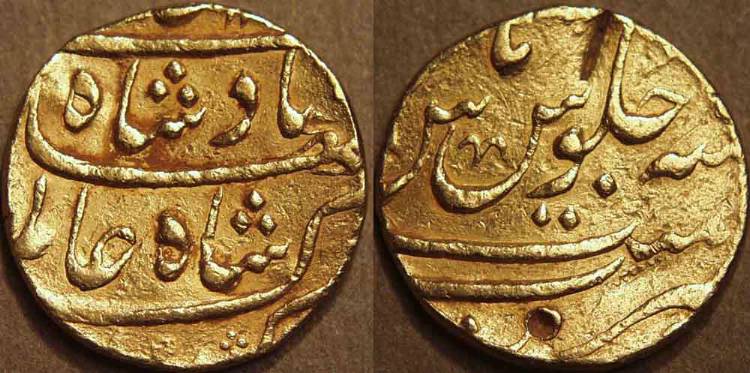
|
Shah Alam Bahadur, 1707-12, Gold mohur, Surat
Weight: 11.04 gm. Diameter: 21 mm Die axis: 2 o'clock
Legend /
Legend
|
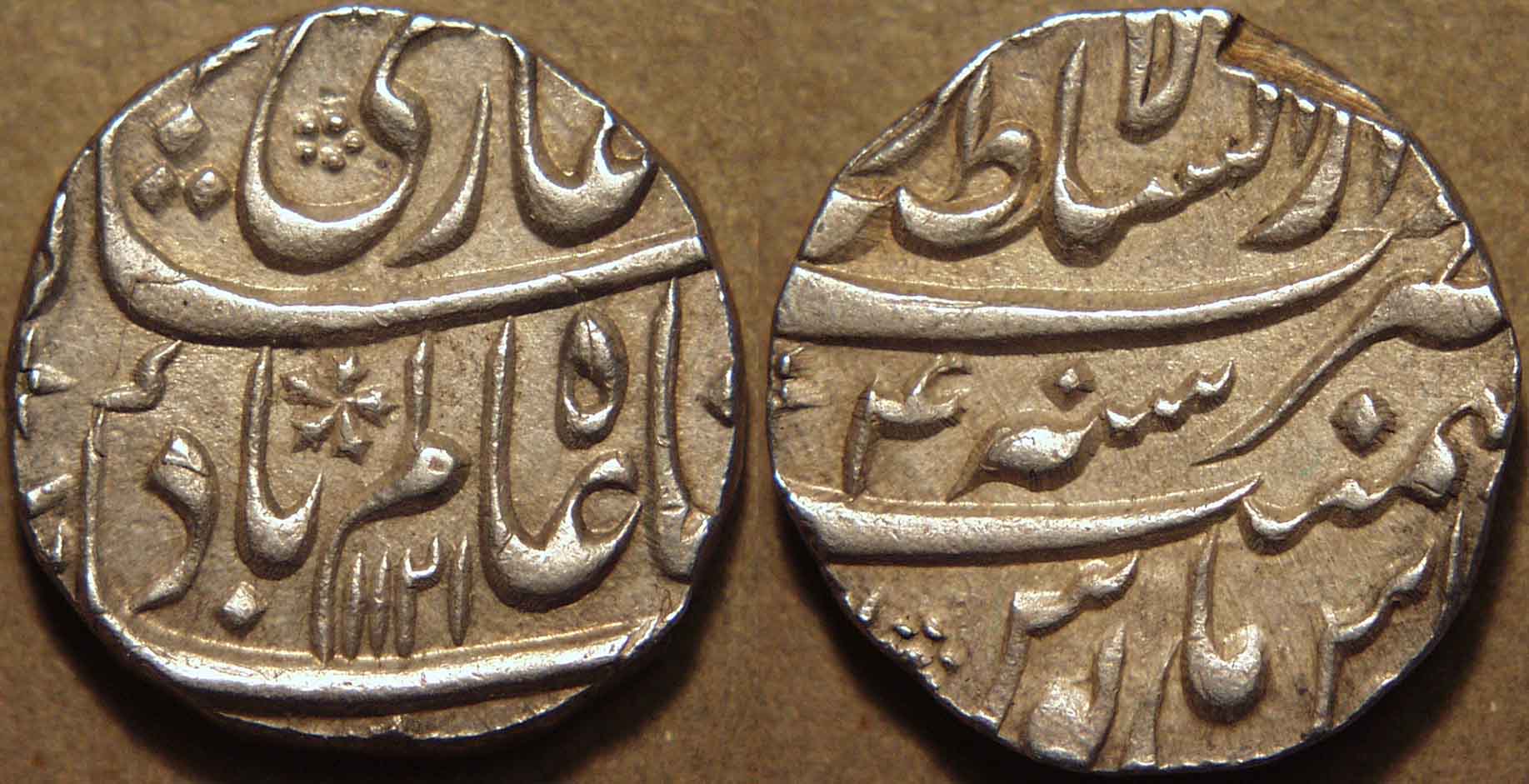
|
Shah Alam Bahadur, 1707-12, Silver rupee, Lahore
Weight: 11.51 gm. Diameter: 22 mm Die axis: 7 o'clock
Legend, with AH date 1121 (=1709-10 CE) /
Legend, with regnal year 4
|
 |
Jahandar Shah (1712) |
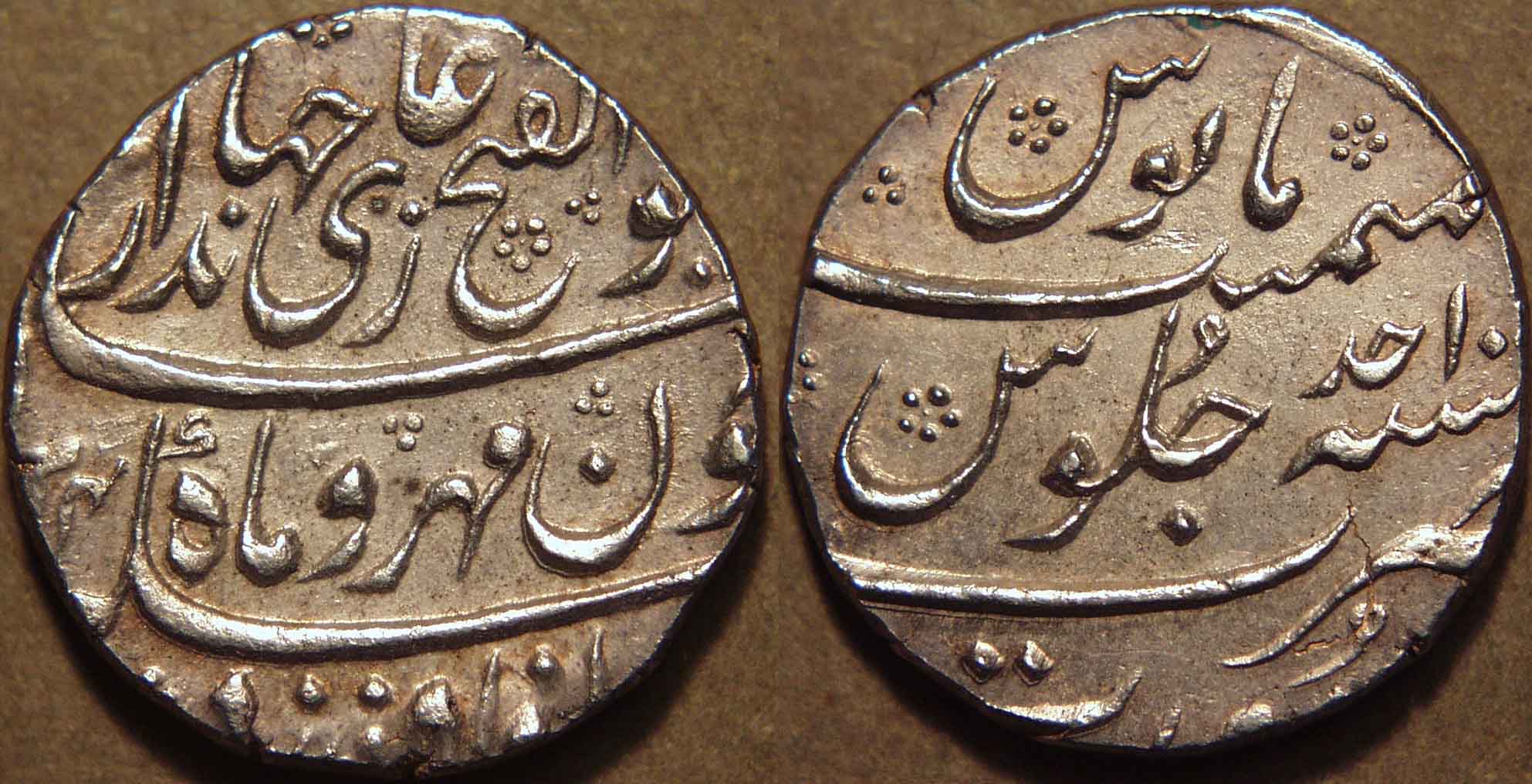
|
Jahandar Shah (1712) Silver rupee, Surat
Weight: 11.50 gm. Diameter: 24 mm Die axis: 11 o'clock
Legend, with AH date (11)24 (=1712-13 CE) /
Legend with RY date 1
|
 |
Farrukhsiyar (1713-1719) |
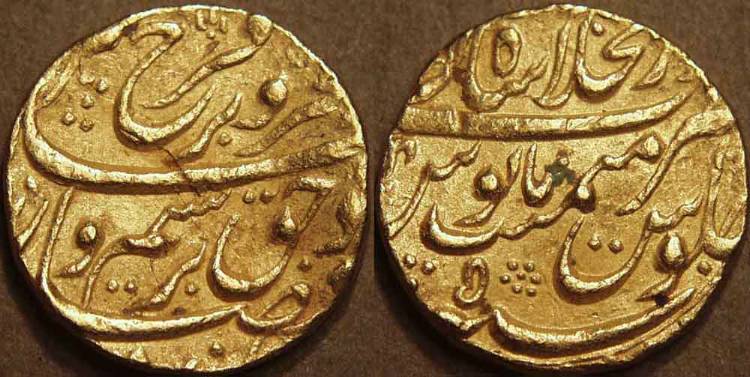
|
Farrukhsiyar, 1713-19, Gold mohur, Shahjahanabad
Weight: 10.90 gm. Diameter: 21 mm Die axis: 11 o'clock
Legend /
Legend with RY date 5 (=1717)
|
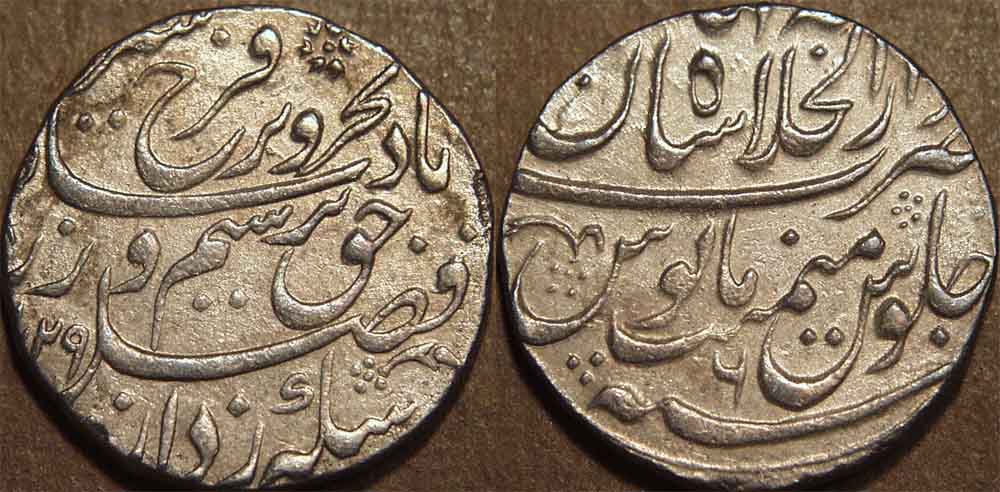
|
Farrukhsiyar, 1713-19, Silver rupee, Shahjahanabad
Weight: 11.40 gm. Diameter: 24 mm Die axis: 7 o'clock
Legend, with AH date (11)29 (=1716-17) /
Legend with RY date 6
|
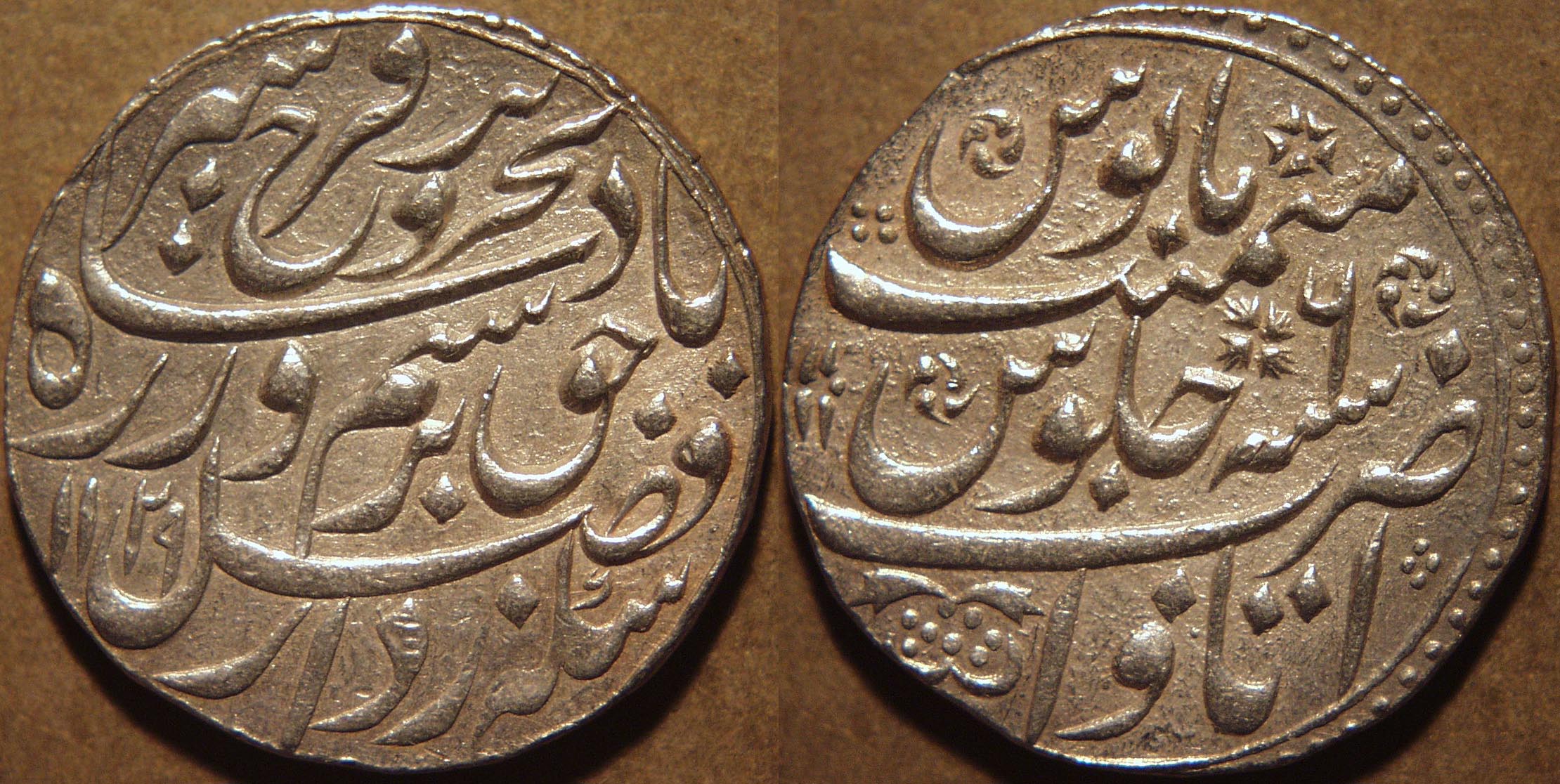
|
Farrukhsiyar, 1713-19, Silver rupee, Itawa
Weight: 11.44 gm. Diameter: 27 mm Die axis: 11 o'clock
Legend, with AH date 1129 (=1716-17) /
Legend with RY date 6
Ref: KM 377.34
|
 |
This coin has a beautiful broad flan that is large enough to show almost the whole coin design.
|
 |
 |
 |
Rafi-ud-Darjat (1719) |

|
Rafi-ud-Darjat, 1719, Silver rupee, Lahore
Weight: 11.48 gm. Diameter: 25 mm Die axis: 4 o'clock
Legend, including AH date (11)31 /
Legend, including mint name Dar-us-Sultanat Lahore, and regnal year 1 (ahd)
Ref: KM 405.13
|
 |
Rafi-ud-Darjat was a 19-year old placed on the throne by the powerful Sayyid brothers. Unfortunately he died just a few
months later, supposedly of lung disease.
|
 |
 |
 |
Shah Jahan II (1719) |
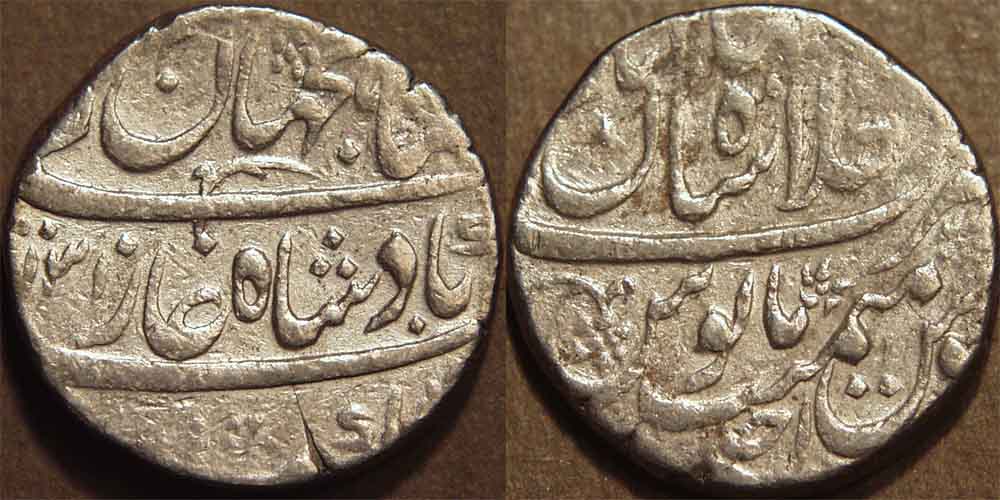
|
Shah Jahan II, 1719, Silver rupee, Shahjahanabad
Weight: 11.35 gm. Diameter: 22 mm Die axis: 4 o'clock
Legend, including AH date 1131 /
Legend, including mint name Dar-ul-Khilafat Shahjahanabad, and regnal year 1 (ahd)
|
 |
Rafi-ud-Daula Shah Jahan II was the older brother of Rafi-ud-Darjat, who was placed on the throne upon the death of
his brother. He also had a short reign of just a few months, also dying supposedly of lung disease.
|
 |
 |
 |
Muhammad Shah (1719-1748) |
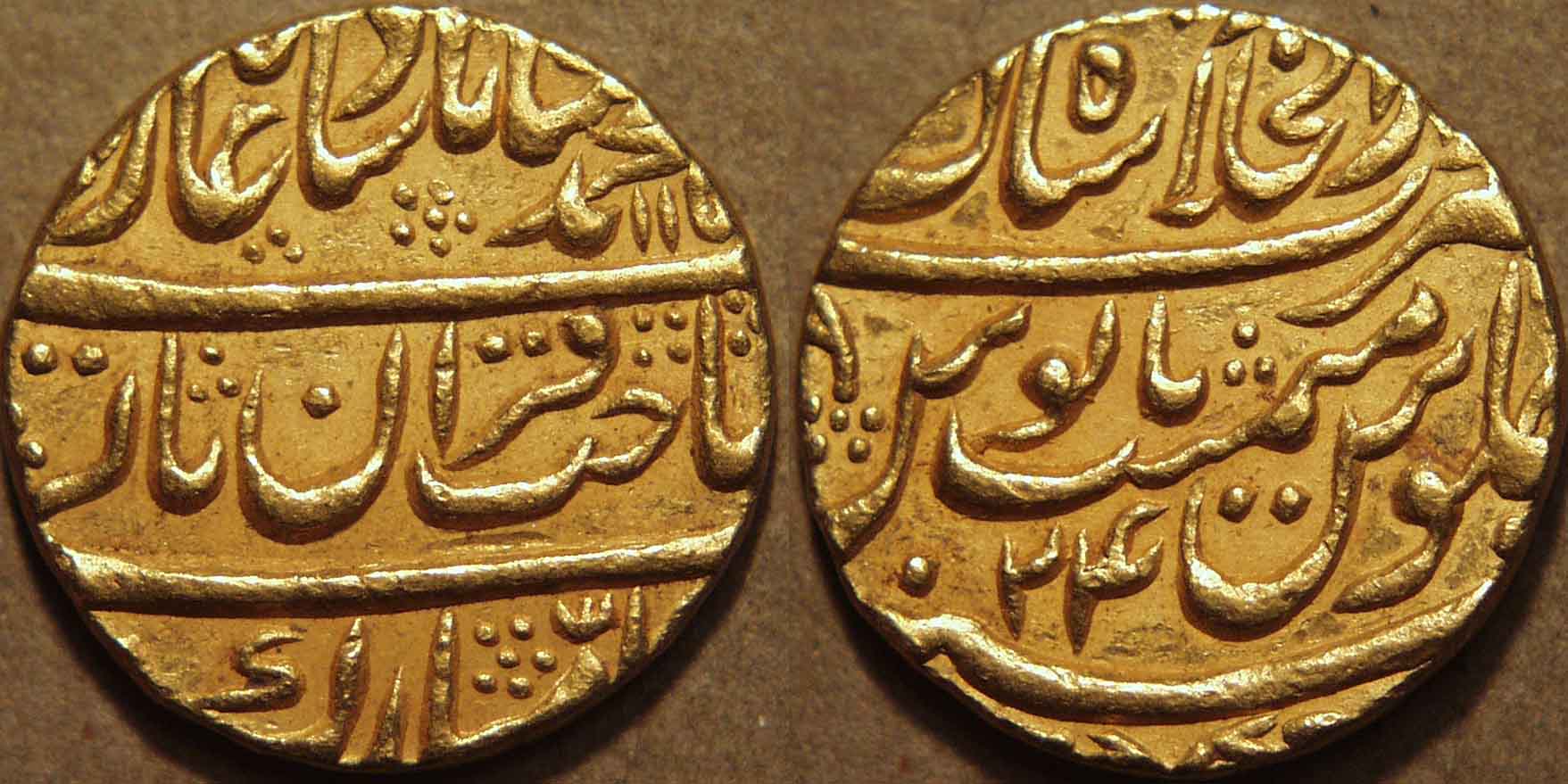
|
Muhammad Shah, 1719-48, Gold mohur, Shahjahanabad
Weight: 10.87 gm. Diameter: 21 mm Die axis: 9 o'clock
Legend, including AH date 115x /
Legend, including RY 24
|
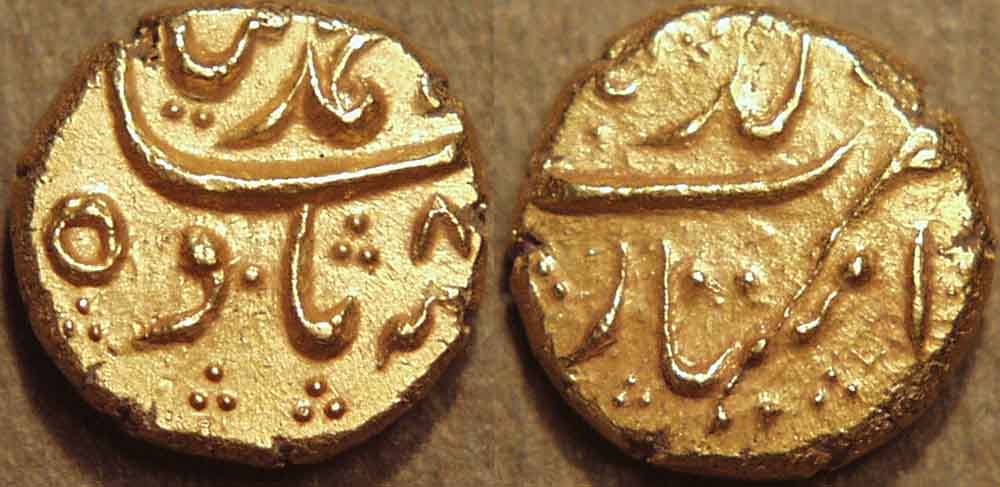
|
Muhammad Shah, 1719-48, Gold pagoda, Imtiazgarh
Weight: 3.34 gm. Diameter: 11 mm Die axis: 11 o'clock
Legend, including RY 8 (= c. 1727 CE) /
Legend, including mint name
|
 |
In the south, coins were minted according to the local pagoda standard.
|

|
Muhammad Shah, 1719-48, Silver rupee, Gwalior
Weight: 11.32 gm. Diameter: 28 mm Die axis: 6 o'clock
Legend, with king's title badshah ghazi, including AH date 11xx (1140 or 1141) /
Legend, including mint name Gwalior, and regnal year 10 ( = 1727-28 CE)
|

|
Muhammad Shah, 1719-48, Silver rupee, Murshidabad
Weight: 11.61 gm. Diameter: 20 mm Die axis: 8 o'clock
Legend, with king's title badshah ghazi, including AH date 11xx (1159 or 1160) /
Legend, including regnal year 29
|
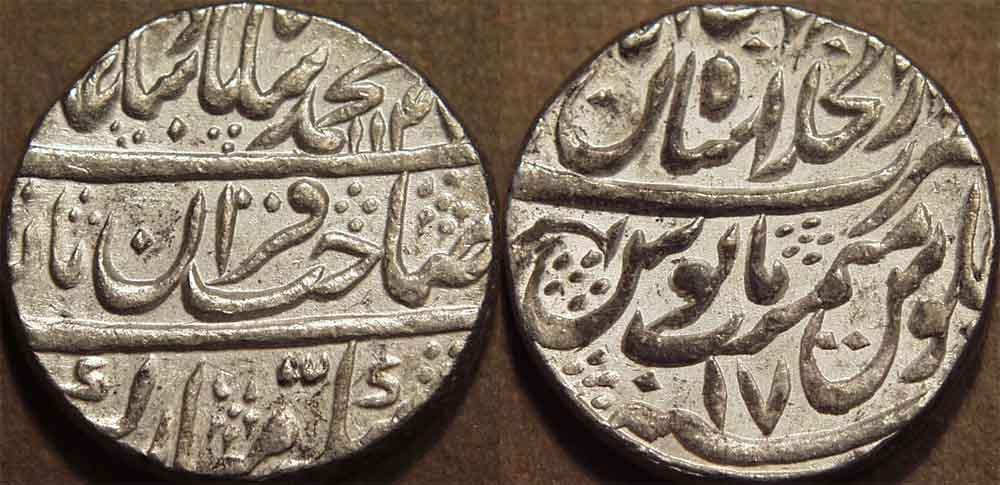 |
Muhammad Shah, 1719-48, Silver rupee, Shahjahanabad
Weight: 11.37 gm. Diameter: 21 mm Die axis: 10 o'clock
Legend, including AH date 1147 /
Legend, including regnal year 17
|
 |
Ahmad Shah Bahadur (1748-1754) |
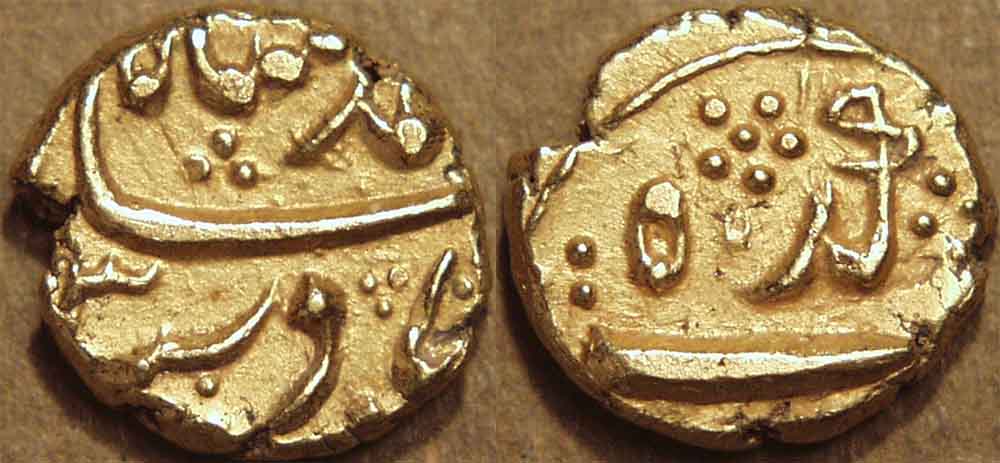
|
Ahmad Shah, 1748-54, Gold pagoda, Imtiazgarh
Weight: 3.30 gm. Diameter: 11-12 mm Die axis: 5 o'clock
Legend, including RY 3 (= c. 1751 CE) /
Legend, including mint name
|
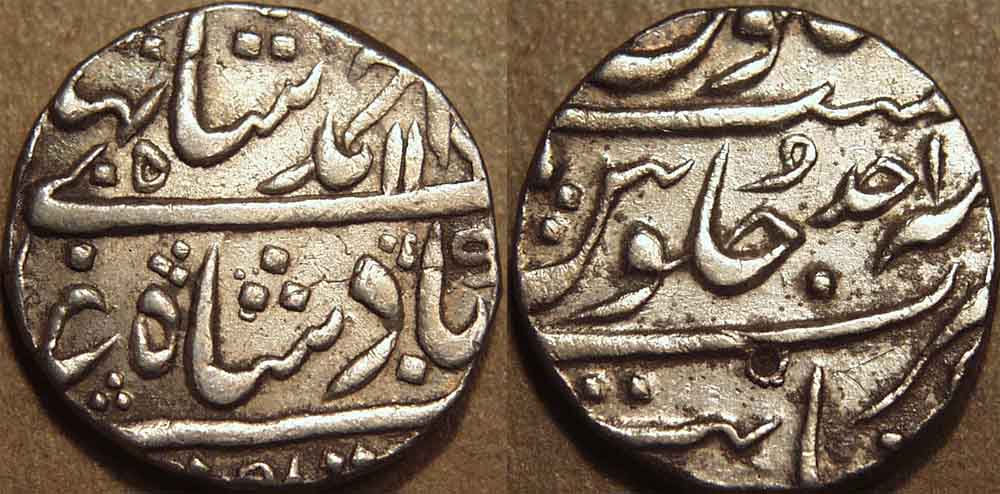
|
Ahmad Shah, 1748-54, Silver rupee, Khambayat (Cambay)
Weight: 11.54 gm. Diameter: 22 mm Die axis: 2 o'clock
Legend, including AH date 11xx (1161) /
Legend, including mint name Khambayat, and regnal year 1
|
 |
Alamgir II (1754-1759) |
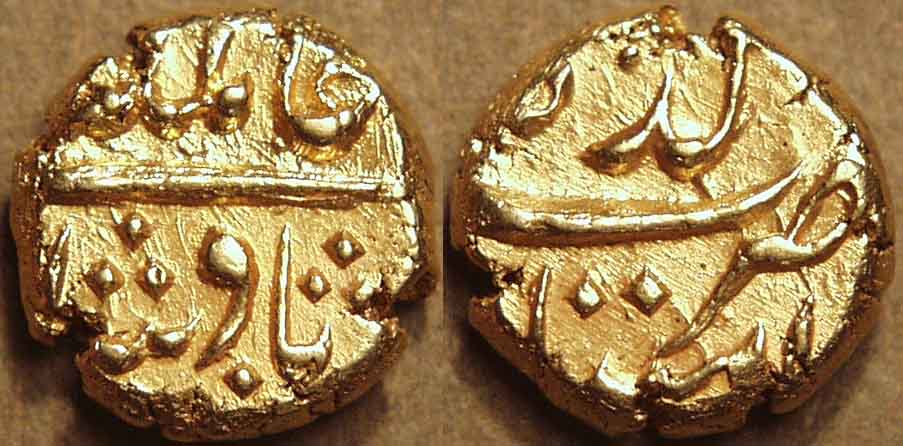
|
Alamgir II, 1754-59, Gold pagoda, Imtiazgarh
Weight: 3.27 gm. Diameter: 11 mm Die axis: 8 o'clock
Legend, no date /
Legend
|
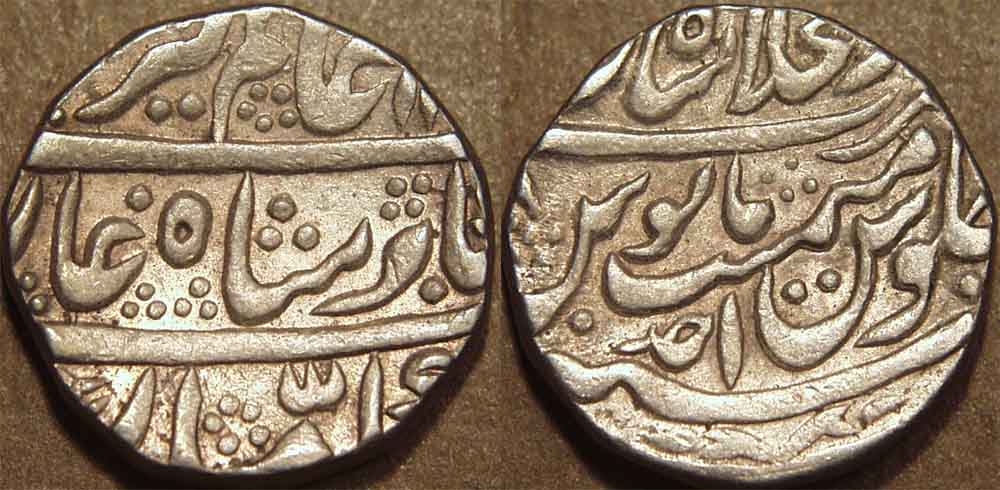
|
Alamgir II, 1754-59, Silver rupee, Shahjahanabad
Weight: 11.37 gm. Diameter: 21-22 mm Die axis: 6 o'clock
Legend, with king's title badshah ghazi alamgir /
Legend, including mint name Dar-ul-khilafat Shahjahanabad, and regnal year 1 ( = 1754-55 CE)
|
 |
Shah Jahan III (1759-60) |
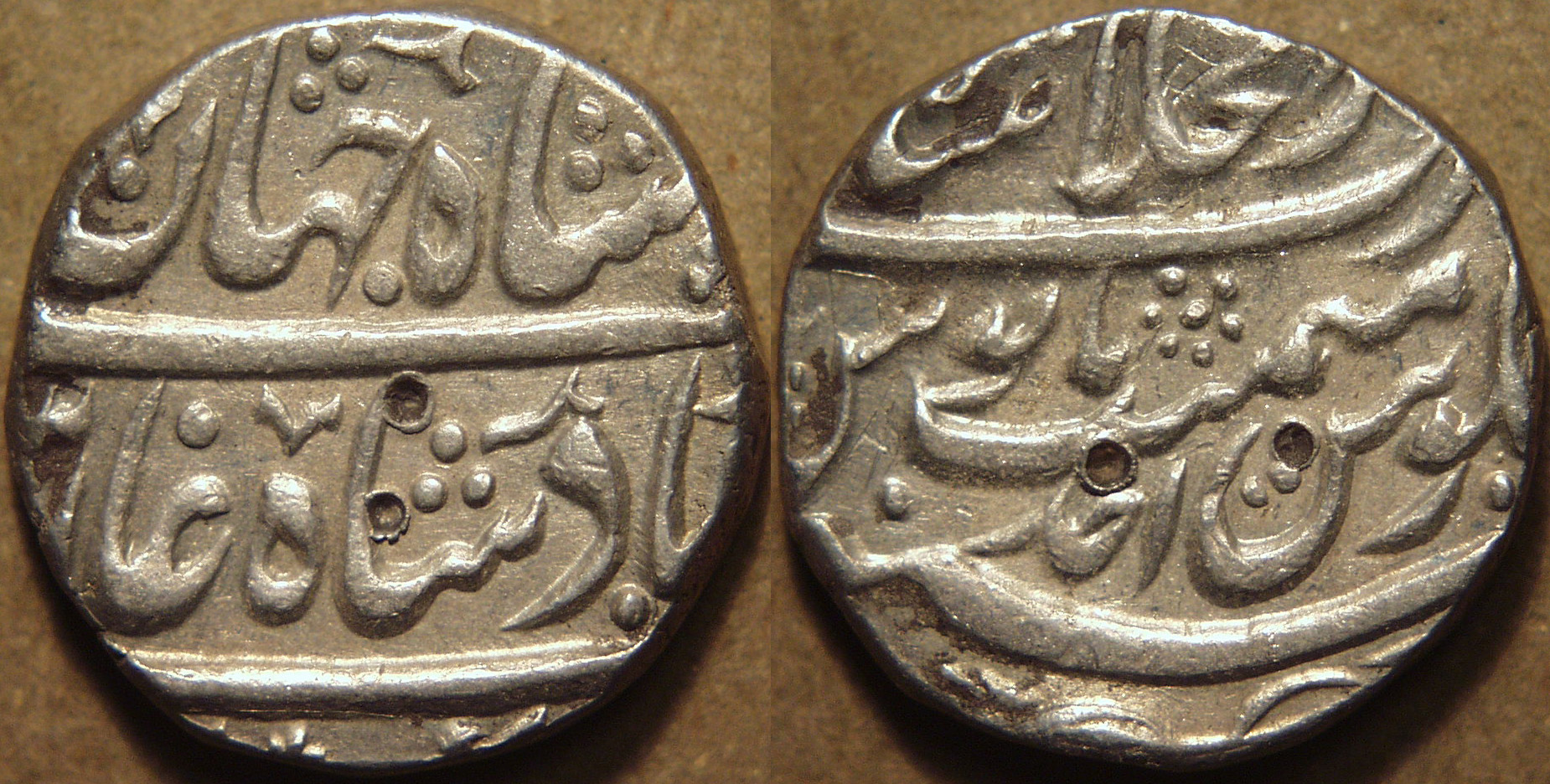
|
Shah Jahan III, 1759-60, Silver rupee, Shahjahanabad
Weight: 11.33 gm. Diameter: 22 mm Die axis: 3 o'clock
Legend, naming Shah Jahan, including AH date (117)3 ( = 1759-60 CE) in the second line of the obverse
Legend, including mint name Dar us Sultanat Shahjahanabad (Delhi), and regnal year 1 (ahd)
Ref: KM 475.3
|
 |
Shah Jahan III was the great grandson of Aurangzeb, who ruled for less than a year during 1759-60. This coin has a
fascinating history. Shailendra Bhandare (Journal of the Oriental Numismatic Society 209) discovered that it was almost certainly struck on 6 August 1760 on the orders
of the invading Maratha general Sadashiv Rao, known as Bhau. Bhau had been ordered by the Peshwa to journey north to provide aid to the beleagured Mughal state in
defense against the invading Afghan armies, but he arrived in Delhi short of funds and in arrears to his troops. Accordingly, he ordered the silver lining on the roof of the
Diwan-i-khas,
the "Hall of Private Audience" in Delhi's Red Fort to be stripped off and converted to coin. Apparently 900,000 coins were struck from that silver and this coin is one of those.
Bhandare was able to figure this out by looking at the placement of the AH date on the coin. Note that it is placed here on the second line of the obverse (only the 3 is
visible on the coin), a practice followed by the Marathas while they occupied Delhi. Shah Jahan III's original rupees placed the AH date on the third line of the obverse. So the
silver in this coin at one time adorned the roof of a major hall at the Red Fort!
|
 |
 |
 |
Shah Alam II (1759-1806) |
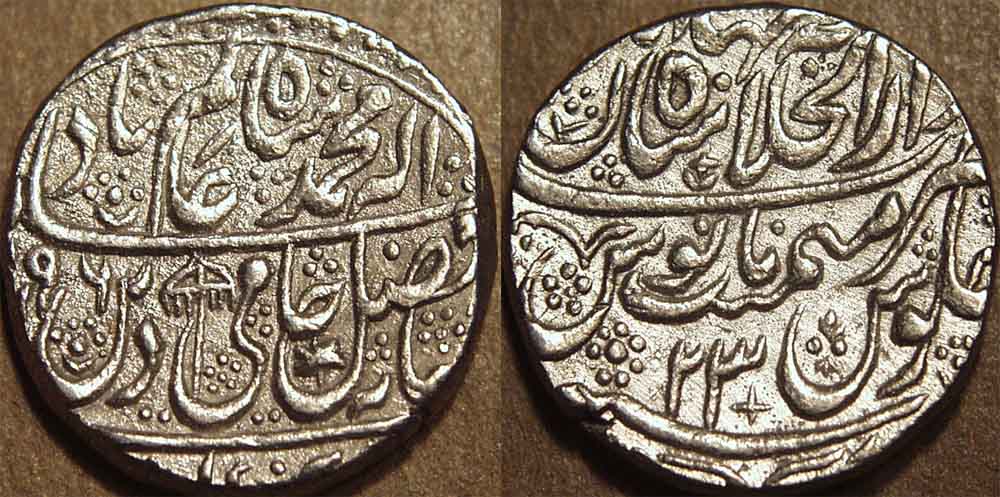
|
Shah Alam II, 1759-1806, Silver rupee, Shahjahanabad
Weight: 11.22 gm. Diameter: 21-22 mm Die axis: 12 o'clock
Legend, naming Shah Alam, including AH date 1196 ( = 1781-82 CE)
and Shahjahanabad mintmark parasol /
Legend, including mint name Dar ul Khilafat Shahjahanabad (Delhi), and regnal year 23
|
 |
Shah Alam II was largely a British puppet, with a very limited degree of control in the limited area around Delhi.
|

|
Shah Alam II, 1759-1806, Silver rupee, Shahjahanabad
Weight: 11.30 gm. Diameter: 21-22 mm Die axis: 7 o'clock
Legend, naming Shah Alam, including AH date 1197 ( = 1782-83 CE)
and Shahjahanabad mintmark parasol /
Legend, including mint name Dar ul Khilafat Shahjahanabad (Delhi), and regnal year 25
|
|
|